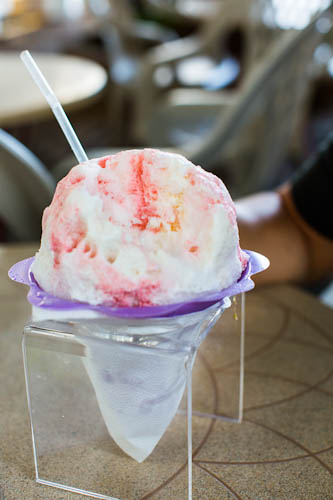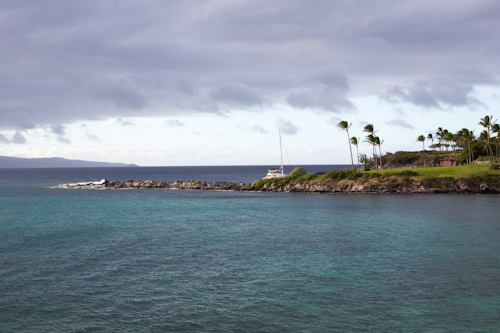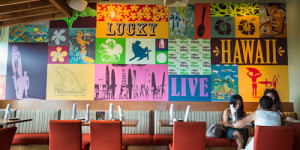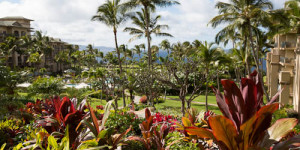Q&A with Chef Peter Merrimanfeatured
I am convinced I was an island girl in a past life. Palm tree dotted vistas, blue skies, candy colored tropical flowers, golden sun…it all speaks to me. I may be back on mainland now, but my mind is still in this happy place…somewhere in Maui with a coconut shave ice in hand.
It’s easy to see how people come to Hawaii and never leave. Take chef Peter Merriman for example. Originally a Pittsburgh native, Merriman got his education at UPenn before embarking on a career in the culinary world. Hawaii lured him away in 1983 and I have a feeling he hasn’t weathered an East coast winter ever since.
Today Merriman has prominent restaurants on the Big Island, Maui, and Kauai. He is the founding president of the Hawaii Regional Cuisine Chefs Organization, and a pioneer in the burgeoning farm-to-table movement in Hawaii.
I had the pleasure of soaking up the drop dead gorgeous ocean view at Merriman’s Kapalua and stealing a few moments with the chef. Here’s what he had to say about Hawaii’s culinary scene, doing the right thing, and three local foods you have to try.
You opened your first restaurant in Hawaii in 1988. How has the culinary scene here grown and evolved over the years? What was it like being a chef here 25 years ago and what is it like now?
The culinary scene in Hawaii and how it’s evolved has just been phenomenal. 27 years ago, it was really just continental cuisine and that was actually a big opportunity for us. We were able to start the farm-to-table movement here in Hawaii about 25 years ago. 25 years ago you couldn’t find fresh basil. And now some of our restaurants are doing as much as 90% locally grown and raised products. The negative side is the cost of fish has gone up about ten-fold from what it was back then. So, we’re worried about the fish. But everything from land is doing really well.
You have been a big proponent of working with local farmers and have been a leading force in the locavore movement here in Hawaii. Can you tell us about the relationships you’ve developed with these farmers, ranchers, and producers?
Having worked with all the farmers and ranchers in Hawaii has been one of the blessings of my life. They are just great people, and they’re doing phenomenal things. It’s been this transition from sugar and pineapple, which were the dominant crops 25 years ago, to now, so many of the farmers are growing crops intended for being eaten here in Hawaii. I’ve gotten to know some great people, and the products they come out with taste so fantastic. The food we have here on Hawaii is unsurpassed. Nobody grows better food than Hawaii.
All your restaurants share the mission statement, “Do the Right Thing.” What does this mean to you?
Well, we try to do the right thing. We don’t have a general guiding philosophy other than to “do the right thing.” So, we try to be involved in the community. We try to be involved with the environment. We try to be involved with the farm-to-table movement. We just try to always contribute to Hawaii. I mean, Hawaii’s such a great place. It’s been great to me, and we just want to do our little part to help give back a fraction of all the things that we’ve gotten from Hawaii.
About Hawaii Regional Cuisine, for people who aren’t sure what that is, what is the heart and soul of Hawaii Regional Cuisine?
I think the heart and soul of Hawaii Regional Cuisine is using Hawaii products. From there, we often cook with a style that reflects the society here in Hawaii, which is a multicultural, middle-of-the-Pacific style, East-meets-West place. There are immigrant groups here from Europe, and there are immigrant groups here from Asia. I feel food really should reflect the culture and so when we do East-West fusion things, it’s an authentic concept because that’s how people eat at home. When they’re barbecuing on the beach here, that’s what they do.
For people who are visiting Maui for the first time, or visiting Hawaii for the first time, what would you say are the top three local foods they must try?
If you’re visiting Hawaii for your first time, here are the top three foods that you should eat:
- You have to have taro, alright, and that doesn’t mean poi. There are a lot of great dishes with taro. Well I love poi, but if it’s your first time to Hawaii, you’re probably not gonna love poi.
- Anything with garlic, ginger, and soy sauce. Shoyu, as we call it in Hawaii. Because that’s the modern interpretation of teriyaki. It’s not so sweet like it used to be. There are wonderful things that can happen with that.
- And then any of our fish. Our fish are so fantastic. But that’s a little obvious. I would say some of our bananas. All of our tropical fruits, they’re exotic and phenomenal.
Is there anything that you can’t get here that you just make a beeline for when get to mainland?
You know, 25 years ago there were a lot of things that we couldn’t get here. But now, I’m satisfied. I never have to leave Hawaii. I’m happy here, and I get everything I want to eat. It’s a great place to live, and it’s a great place to be a chef.
You don’t get a late night craving for a Philly Cheesesteak?
We can make a cheesesteak! And now we can make a cheesesteak with the bread that’s baked here, and the cattle are raised here, and even the possibility that the cheese was made here. And onions of course!
What was the last great dish or meal you had?
Well I just got done making a new dish that we’re working on which is a cornmeal dusted opakapaka, which we’re putting on jalapeno mashed potatoes, and we’re gonna have a Kula tomato pico de gallo on that, and we’re taking Kauai prawns and putting it on top of that, and then we’re making a macadamia nut mole vinaigrette to go around it. It just came out so great that I’m excited about it.
Man, you just made me hungry.
Oh, right on! Good good, that’s the idea. That’s what we try to do.
What’s in store for the future? Do you have any new projects or ventures coming up that we should know about?
Well we’re going to open up Monkeypod Kitchen by Merriman in Ko’Olina, Oahu. That’s going to open in November. That’s our most exciting project at this particular point.










Add comment